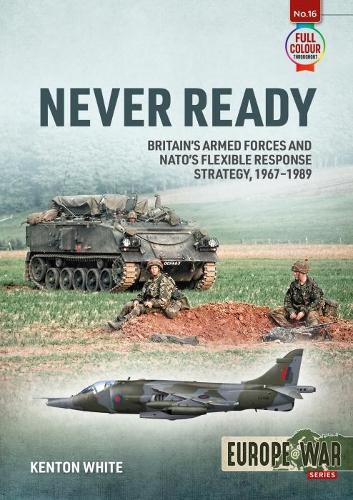
Never Ready: NATO's Flexible Response Strategy, 1968-1989
(Paperback)
Publishing Details
Never Ready: NATO's Flexible Response Strategy, 1968-1989
By (Author) Kenton White
Helion & Company
Helion & Company
3rd February 2022
28th November 2021
United Kingdom
Classifications
General
Non Fiction
European history
355.03354109045
Physical Properties
Paperback
102
Width 210mm, Height 298mm
Description
Was Britain's implementation of NATO strategy credible After the adoption of Flexible Response in 1967 NATO relied on conventional forces to defend the West. Britain had a central role in NATO's plans, but was British defense planning adequate for the task How did the Government plan for the use of the conventional Armed Forces for the range of operations it was committed to How were the Armed Forces to be mobilised, and what was the detail of the planning for mobilisation In 1967 MC14/3 was adopted as the overall strategic concept by NATO. It relied on an escalatory deterrence, from conventional through tactical nuclear strikes to strategic nuclear attack. This is commonly known as Flexible Response and replaced NATO's trip-wire response. The declared principal of the strategic concept was to reduce the chance of mistakenly starting a nuclear war, meeting force with like force, and raising the nuclear threshold in the event of actual war. By using newly available documents from British and other archives, this volume will show that far from being a flexible strategy, in the event of a war it was doomed to failure. The concept was compromised by the failure of the Alliance members to provide one of the main legs of the conventional deterrent sustainability. This book analyses the paradox between the public face of defense policy and the practice. The book assesses whether the planning would have worked, and what would have happened in Europe if war had broken out. To answer this question the research looks at the conflicts in the Falklands and the Gulf to assess the feasibility of the plans in place. Elements upon which British defense depended were still being built more than twenty years after the new strategy was adopted. Defense policy in Britain was concerned less with the threats the country faced than with just how little could be spent on defense.Was Britain's implementation of NATO strategy credible After the adoption of Flexible Response in 1967 NATO relied on conventional forces to defend the West. Britain had a central role in NATO's plans, but was British defense planning adequate for the task AUTHOR: The author is a lecturer in Strategic Studies at RAF Cranwell and the University of Reading. He has had a life-long interest in the Peninsular War and the armies involved. 15 b/w photos, 89 colour photos, 3 charts, 22 colour profiles, 8 colour maps, 1 table
Reviews
"The Cold War and hypothetical Third World War crowd will find the analysis interesting." * Historical Miniatures Gaming Society *
"...if you are interested in how a member of NATO could meet its obligations to the alliance, this is a welcome addition to any collection." * IPMS/USA *
Author Bio
The author is a lecturer in Strategic Studies at RAF Cranwell and the University of Reading. He has had a life-long interest in the Peninsular War and the armies involved.
